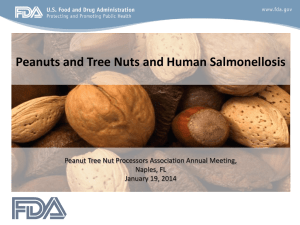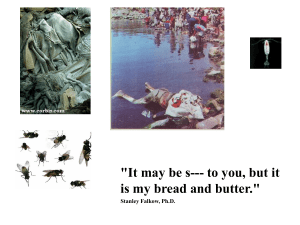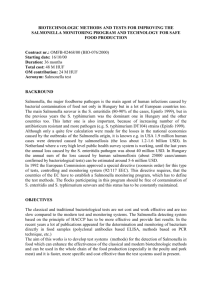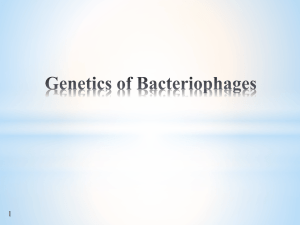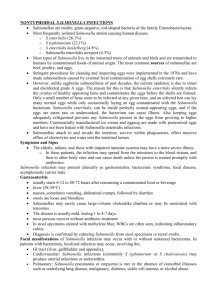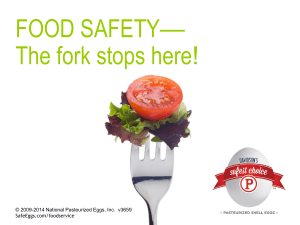Executive summary - Food Standards Australia New Zealand
advertisement
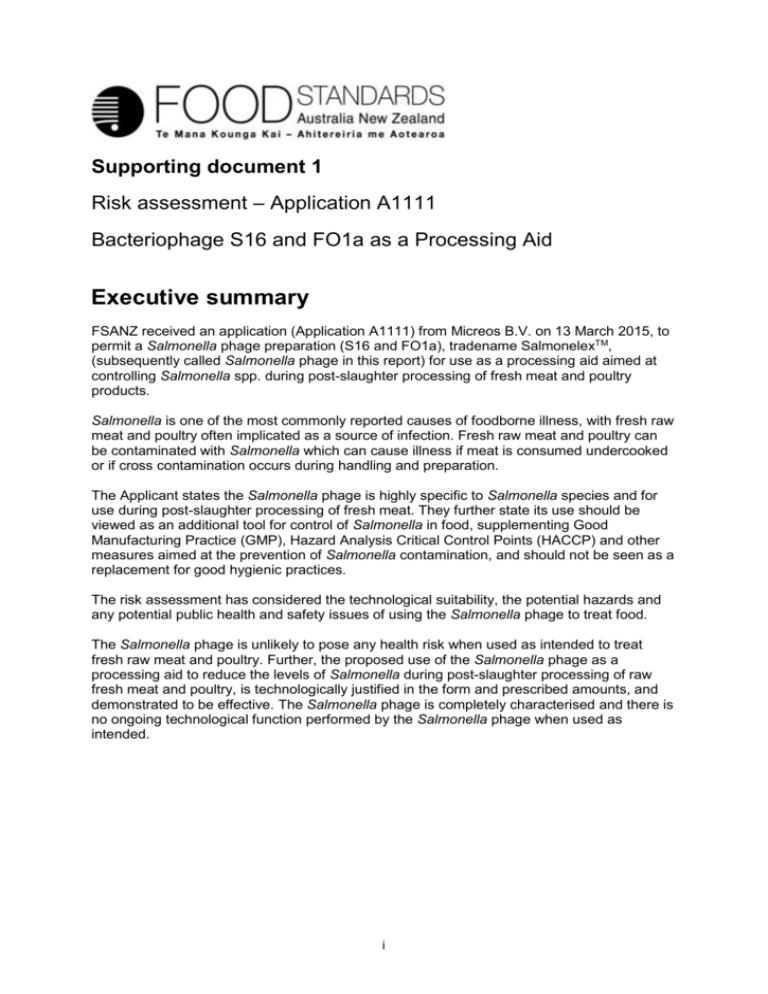
Supporting document 1 Risk assessment – Application A1111 Bacteriophage S16 and FO1a as a Processing Aid Executive summary FSANZ received an application (Application A1111) from Micreos B.V. on 13 March 2015, to permit a Salmonella phage preparation (S16 and FO1a), tradename SalmonelexTM, (subsequently called Salmonella phage in this report) for use as a processing aid aimed at controlling Salmonella spp. during post-slaughter processing of fresh meat and poultry products. Salmonella is one of the most commonly reported causes of foodborne illness, with fresh raw meat and poultry often implicated as a source of infection. Fresh raw meat and poultry can be contaminated with Salmonella which can cause illness if meat is consumed undercooked or if cross contamination occurs during handling and preparation. The Applicant states the Salmonella phage is highly specific to Salmonella species and for use during post-slaughter processing of fresh meat. They further state its use should be viewed as an additional tool for control of Salmonella in food, supplementing Good Manufacturing Practice (GMP), Hazard Analysis Critical Control Points (HACCP) and other measures aimed at the prevention of Salmonella contamination, and should not be seen as a replacement for good hygienic practices. The risk assessment has considered the technological suitability, the potential hazards and any potential public health and safety issues of using the Salmonella phage to treat food. The Salmonella phage is unlikely to pose any health risk when used as intended to treat fresh raw meat and poultry. Further, the proposed use of the Salmonella phage as a processing aid to reduce the levels of Salmonella during post-slaughter processing of raw fresh meat and poultry, is technologically justified in the form and prescribed amounts, and demonstrated to be effective. The Salmonella phage is completely characterised and there is no ongoing technological function performed by the Salmonella phage when used as intended. i Table of contents EXECUTIVE SUMMARY............................................................................................................................... I 1 2 INTRODUCTION ........................................................................................................ 2 BACKGROUND ........................................................................................................ 2 Bacteriophages and their mode of action ...................................................................................2 Salmonella phage mode of action ................................................................................................3 3 OBJECTIVES OF THE ASSESSMENT ........................................................................... 4 4 RISK ASSESSMENT QUESTIONS ................................................................................ 4 5 CHARACTERISATION OF SALMONELLA PHAGE .......................................................... 4 5.1 Physical properties of Salmonella phage ....................................................................................4 5.2 Identity of phage components.......................................................................................................4 5.3 Identification of the host (production) organism .........................................................................5 5.4 Production of Salmonella phage ..................................................................................................5 5.5 Potential presence of allergens ....................................................................................................6 5.6 Analytical methods .........................................................................................................................6 5.7 Specifications ..................................................................................................................................6 6 TECHNOLOGICAL FUNCTION .................................................................................... 8 6.1 Technological purpose of Salmonella phage .............................................................................8 6.2 Evaluation of efficacy .....................................................................................................................8 6.3 Discussion .....................................................................................................................................16 6.4 Conclusion .....................................................................................................................................17 7 HAZARD ASSESSMENT .......................................................................................... 17 7.1 Potential toxicity ............................................................................................................................17 7.2 Potential allergenicity ...................................................................................................................18 7.3 Conclusion .....................................................................................................................................18 8 DIETARY EXPOSURE ............................................................................................. 18 9 RESPONSE TO RISK ASSESSMENT QUESTIONS ...................................................... 18 10 CONCLUSION ........................................................................................................ 19 REFERENCES ............................................................................................................... 19 2.1 2.2 1 1 Introduction FSANZ received an application (Application A1111) from Micreos B.V. on 13 March 2015, to permit a Salmonella phage preparation (S16 and FO1a), tradename SalmonelexTM, (subsequently called Salmonella phage in this report) for use as a processing aid aimed at controlling Salmonella spp. during post-slaughter processing of fresh meat and poultry products. Salmonella is one of the most commonly reported causes of foodborne illness, with fresh raw meat and poultry often implicated as a source of infection. Fresh raw meat and poultry can be contaminated with Salmonella which can cause illness if meat is consumed undercooked or if cross contamination occurs during handling and preparation. The Applicant states the Salmonella phage is highly specific to Salmonella species and for use during post-slaughter processing of fresh meat. They further state its use should be viewed as an additional tool for control of Salmonella in food, supplementing Good Manufacturing Practice (GMP), Hazard Analysis Critical Control Points (HACCP) and other measures aimed at the prevention of Salmonella contamination, and should not be seen as a replacement for good hygiene. 2 Background 2.1 Bacteriophages and their mode of action Bacteriophages are viruses that attach to and replicate only in bacteria. They are ubiquitous, occupying every environmental niche and are present in large numbers in the environment, including food. Bacteriophages are highly specific to the bacterial species they infect and cannot infect plant, animal or human cells. Ingested bacteriophages pass through the gut without causing any hazard to humans. Bacteriophages are non-motile, lacking the ability to actively locate bacterial cells. They rely on diffusion to randomly encounter and attach to host bacterial cells. Once attached to the host cell, bacteriophage can follow two pathways – the lytic1 cycle and the lysogenic2 cycle. Those that can only follow the lytic cycle are known as virulent bacteriophage, while those that can follow the lysogenic cycle are known as temperate bacteriophage. FSANZ has previously described in detail the mode of action, use and safety considerations for use of bacteriophages in foods during consideration of the Listeria phage P100 application, A1045 – Bacteriophage Preparation P100 as a Processing Aid (FSANZ 2012). Readers are referred to this document for further information3. 1 The lytic cycle is where bacteriophage undergoes replication within the bacterial host cell, with release of phage particles upon rupturing of the host cell. This cycle does not integrate phage genetic material into the bacterial chromosome. 2 The lysogenic cycle is where the genetic material of the bacteriophage integrates with the chromosome of the bacterial host, enabling it to lie dormant and to release phage particles when conditions are suitable. The lysogenic cycle provides a mechanism whereby toxin genes may be spread or exchanged between bacteria, altering their virulence properties. 3 http://www.foodstandards.gov.au/code/applications/Pages/applicationa1045bact4797.aspx 2 2.2 Salmonella phage mode of action Two specific bacteriophages make up the Salmonella phage – S16 and FO1a. Both phages are virulent (non-temperate) phage and the genetic structure of the genome excludes any possible presence of a lysogeny module. S16 specifically recognises the Salmonella outer membrane protein C (ompC) which allows it to attach to strains that have rough or deep rough mutations, thus not requiring intact lipopolysaccharide (LPS) structure. It has a dsDNA 160 kb genome comprising 269 putative coding sequences and 3 tRNA genes. The DNA is highly modified which allows the phage to infect Salmonella strains carrying restriction modification systems, perhaps the most common and well known bacterial phage defence mechanisms (Marti et al. 2013). Felix-O1 like phages, such as FO1a, utilise different receptor molecules to those of S16, recognising the terminal N-acteylglucosame residue of the outer LPS core. S16 features a complex replication mechanism and DNA packaging mode, while FO1a has fixed terminal repeats of 570 nt, which rules out the possibility for generalised transduction of host DNA. 2.2.1 Host range Marti et al. (2013) tested the infection specificity of phage S16 against 32 strains from the genus Salmonella, 14 S. Typhimurium LPS mutants and six laboratory strains of Escherichia coli. Phage S16 was able to lyse all Salmonella strains with the exception of a single clinical S. Enteritidis strain. E. coli was found to be generally insensitive to S16, despite the presence of ompC. It was concluded that S16 adsorbs to Salmonella ompC and not to E. coli ompC. Information provided by the Applicant demonstrated the sensitivity of over 200 S. enterica strains, which included clinical and poultry isolates, to the Salmonella phage. No strains were found to survive phage treatment. Additionally, isolates from the Salmonella enterica subspecies houtenae, salamae, arizonae and diarizonae and the genus S. bongori were all found to be sensitive to the Salmonella phage. Strains from Escherichia, Cronobacter, Enterobacter, Citrobacter, Klebsiella, Vibrio, Campylobacter and Pseudomonas were not susceptible to the Salmonella phage, with the exception of a single E. coli stain susceptible to FO1a only. Data presented in the Application demonstrate the Salmonella phage has a broad host range specific to the genus Salmonella. Other related genuses such as Escherichia are not susceptible despite the presence of an ompC. 2.2.2 Phage-resistant bacterial strains The efficacy of any bacteriophage-based preparation would be reduced in the presence of phage-resistant bacterial strains. Bacterial resistance can occur naturally or be acquired via normal stress-response mechanisms following exposure to any bactericidal treatment (biological, chemical or physical). Given the nature of application (high dosage of bacteriophage to low numbers of target bacteria), the breadth of the host range (section 2.2.1), and use of Good Hygienic Practices (GHP) in the production facility, the potential for reduced efficacy of the Salmonella phage due to the presence of phage-resistant Salmonella is minimal. This view is consistent with that of other international regulators regarding the application of bacteriophages in food manufacture. 3 2.2.3 Transfer of antimicrobial resistance genes As discussed in section 2.2, Salmonella phages S16 and FO1a lack the mechanisms to transfer genetic material. Marti et al. (2013) investigated the ability of two phages, S16 (lytic) and P22 (lysogenic) to transfer antibiotic resistance genes between Salmonella strains. The phage lysate from a chloramphenicol resistant strain of Salmonella was used to infect a kanamycin resistant Salmonella strain. The resulting cultures were then grown on plates which contained both chloramphenicol and kanamycin. Salmonella colonies resistant to both chloramphenicol and kanamycin were observed when the lysogenic P22 phage was used. No transfer of antibiotic resistance was observed for the lytic S16 phage. 3 Objectives of the assessment In proposing to amend the revised Australia New Zealand Food Standards Code (the Code) (which commences on 1 March 2016), to include the Salmonella phage as a processing aid, a pre-market assessment is required. The objectives of this risk assessment are to determine whether: the Salmonella phage achieves its stated technological function any potential health and safety concerns may arise from the use of the Salmonella phage as a processing aid. 4 Risk assessment questions The following risk assessment questions have been developed to address the objectives of the assessment: Is the Salmonella phage sufficiently characterised? Does the Salmonella phage achieve its stated technological function? Is the Salmonella phage safe for its intended use? 5 Characterisation of Salmonella phage The Salmonella phage of the Application, with a commercial name of SalmonelexTM, is a blend of equal amounts of two specific bacteriophages that are both specific to Salmonella, being S16 and FO1a. 5.1 Physical properties of Salmonella phage The Salmonella phage is an opaque liquid containing 2x1011 plaque forming units (pfu) per mL, in buffered saline. It contains equal amounts of two specific bacteriophages, S16 and FO1a. Both these phages are strictly virulent (lacking lysogenic activity). Both phage preparations are grown from cell cultures of Salmonella bongori. 5.2 Identity of phage components Identity of bacteriophage S16 Order: Family: Genus: Species: Caudovirales Myoviridae T4-like viruses Salmonella phage S16 4 Host specificity: Specific to all strains of Salmonella tested Phage S16 was isolated by the Applicant (Micreos) in The Netherlands. It is a virulent (strictly lytic) phage belonging to the T4 family of phages having specificity to all Salmonella species and subspecies tested, therefore having a broad range of efficacy (Marti et al. 2013). Identity of bacteriophage FO1a Order: Family: Genus: Species: Host specificity: Caudovirales Myoviridae FelixO1-like phages Salmonella phage FO1a Specific to a large number of strains of Salmonella Phage FO1a was isolated by scientists at EPH Laboratories. It is almost identical (>99.99%) to the well-studied Felix-O1 phage (Whichard et al. 2003). The full genomic sequences of both phages are in the public domain. Genbank accession numbers are HQ331142 (S16) and JF461087 (FO1a). 5.3 Identification of the host (production) organism Name of host organism: Literature: Risk group: Type strain and registry numbers: Salmonella bongori Le Minor et al. (1985) Int. J. Syst. Bacteriol. 39:371 2 (German classification) NCTC 12419, DSM 13772, ATCC 43975 Salmonella bongori are associated with reptiles and amphibians, rather than mammals and do not usually cause infection in humans. Although S. bongori feature a similar pathogenicity island 1 (SP1) to Salmonella enterica species, they lack the pathogenicity island 2 (SP2) (Ochman and Groisman 1996). It is SP2 which produces Salmonella enterotoxin (stn). Use of S. bongori as the host organism during production of Salmonella phage, therefore precludes production of stn during phage propagation. 5.4 Production of Salmonella phage Standard fermentation procedures are employed for the production of the Salmonella phage which occurs in bioreactors. Both phages are grown separately on the same S. bongori production strain and consist of the following steps: 5.4.1 Fermentation Phages for infecting the production strain are added as required and fermentation initiated. Once growth commences, the culture is further incubated under agitation and aeration conditions. 5.4.2 Downstream processing Following completion of the incubation, the culture is centrifuged to remove bacterial debris. Further debris is removed by filtration steps. The phage solution is further purified and concentrated by anion exchange chromatography to remove medium components, host proteins and lipopolysaccharides. The bound phages are released from the chromatography column using a peptone-salt buffer. The phage solution is further purified by sterile filtration. 5 The phage solutions of both S16 and FO1a are diluted with sterile water to the appropriate concentration of 1x1011 pfu/mL and blended to produce the final commercial phage preparation. 5.4.3 Quality Assurance Batches of the commercial phage preparations undergo quality control testing against company specifications before product is released. Phage titration testing is done to ensure they meet potency of 2x1011 pfu/mL +/- 10%. Sterility of the product is ensured by testing 1% of each batch by a 5-day enrichment test in selective bacterial medium, checked by plating. Endotoxin testing is also performed for each lot. 5.5 Potential presence of allergens Soy peptone is used as a medium in the production of the Salmonella phage. A soy peptonesalt buffer is used to elute the bound phages from the chromatography column. Soybean products are identified as substances requiring declaration due to section 1.2.3—4 of the Code if present in a food for sale. Food manufacturers who use the Salmonella phage as a processing aid need to be aware of their responsibilities under section 1.2.3—4. 5.6 Analytical methods The activity of the Salmonella phage is defined by the ability to destroy target bacterial cells (Salmonella) and therefore expressed as the reduction of bacterial numbers. To analyse for the presence of the two bacteriophages in bacteriophage treated food products, a standard agar overlay method can be employed. Information on the plating method is provided in the Application. The phages will be bound on the surface of the treated food (so are inactive since they are not motile but may not be degraded if the treatment was relatively recent) and can be recovered by stomaching in a buffer. This fluid is sterile filtered and a 10-fold dilution series made. Agar plates of the phage-sensitive bacteria (i.e. Salmonella) are made and then samples of the dilution series are poured onto these standard agar plates. Overnight incubation will result in the host bacterial cells having grown uniformly throughout the top agar layer (forming a bacterial ‘lawn’) and bacteriophage are enumerated by assaying plaques caused by cell lysis, being expressed as plaque forming units (pfu) per gram (g) of the initial solid food. Subsequent information requested from the Applicant provided information relating to a polymerase chain reaction (PCR) analytical method applicable for determining the presence of the bacteriophages on treated food. To confirm the presence of the Salmonella phage, a PCR method is applied using four available primers. This analytical method is available and could be used by analytical laboratories for enforcement purposes if required. 5.7 Specifications The Applicant has provided three Certificates of Analysis from which specifications for the Salmonella phage can be determined (Table 1). 6 Table 1: Specifications derived for Salmonella phage from Certificates of Analysis provided by the Applicant Physical Properties Specification Suspension of broad spectrum4 phage preparation formulated in sterile water Fermentation derived 2x1011 pfu/mL Description Source Phage concentration Chemical Properties Lead Arsenic Mercury Microbiological Properties Endotoxin level <8 μg/L <2 μg/L <0.5 μg/L <250,000 EU/mL There is no specification for the Salmonella phage in the reference monographs in the Code, being sections S3—2 (primary sources) or S3—3 (secondary sources), or other specifications in Schedule 3. There is a specification for another phage, Listeria phage P100 (earlier Application A1045 from the same Applicant), in section S3—16 of Schedule 3. This P100 specification provides the biological classification of the phage for full identification. The identification (biological classification) of the two phages, S16 and FO1a, is viewed as the appropriate information for the specification of the phage for this Application, to be added to the Code. This information is provided below. For the Salmonella phage S16, the biological classification is the following: Order – Caudavirales Family – Myoviridae Genus – T4-like Species – Salmonella phage S16 GenBank Accession Number – HQ331142 For the Salmonella phage FO1a, the biological classification is the following: Order – Caudavirales Family – Myoviridae Genus – FelixO1-like Species – Salmonella phage FO1a GenBank Accession Number – JF461087 A report on the stability of the Salmonella phage under long term storage is included in the Application. The recommended storage temperature is 2–6C. At these storage temperatures, the designated shelf life of the phage preparation is six months. 4 Broad host range bacteriophages are capable of infecting a wide range of host strains within the bacterial species they infect. 7 6 Technological function 6.1 Technological purpose of Salmonella phage The Applicant claims the stated purpose (technological purpose) of their phage preparation (SalmonelexTM) is to reduce levels of Salmonella post-slaughter on beef, pork and poultry. The intended use is on carcasses, fresh pork cuts, fresh beef cuts and fresh poultry carcasses or meat. Further, the Applicant claims the technological function of the Salmonella phage is as a processing aid, having no on-going technological function. 6.2 Evaluation of efficacy FSANZ has investigated how the Salmonella phage performs its technological function when used as proposed by the Applicant. In assessing the technological function, both efficacy (ability to reduce numbers of Salmonella on application) and ongoing technological function (ability to continuously reduce bacterial numbers) were considered. The majority of the challenge studies provided in the Application to show efficacy and technological function were performed at 4°C. There is one exception; a study where Salmonella phage treated pork was stored at room temperature after an initial eight hour period at 4°C. Salmonella does not grow at 4°C, with minimum growth temperature reported to be 5.6°C (FSANZ 2013). Since Salmonella doesn’t grow at 4°C, the statistical analysis of the challenge studies for the Salmonella phage is different to that undertaken for the previously assessed bacteriophage, Listeria phage P100. During the initial stages of bacterial growth the cell concentration increases exponentially i.e. the logarithm of cell concentration increases linearly with time. For the assessment of Listeria phage P100, regression lines were fitted to the control and phage treated growth data. Efficacy was estimated by the difference in the intercepts between the control and treatment groups. On-going technological function was evaluated by comparing the slopes of the lines for the control and treatment groups. Where the slopes were the same, there was no on-going technological function. This was the case for the majority of challenge studies for solid foods. By comparison, when Listeria phage P100 was added to liquid foods such as chocolate milk, the lines were not parallel indicating on-going technological function. No challenge study data for liquid foods was provided in this current Application. It may be hypothesised that for Salmonella on solid foods treated with the Salmonella phage and stored at 4°C, the regression lines fitted to the control and treatment concentration data would be parallel but with slopes equal to zero (i.e. horizontal lines) as no growth would occur. A difficulty in analysing data for Salmonella below the minimum growth temperature is the possibility of non-thermal inactivation due to cold temperatures which are unrelated to the presence the Salmonella phage. For this Application, on-going technological function has been qualitatively assessed from the changes in Salmonella concentration throughout duration of the challenge studies provided by the Applicant. Efficacy was determined using a multiple comparison statistical test (Tukey Honest Statistical Difference) of the Salmonella concentrations between the untreated (Control) samples at the start of the experiment (time = 0) and the phage treated samples at different times. 8 The challenge studies provided in the Application can be divided into two groups: (1) direct application onto the surface of foods; and (2) indirect application by dipping of foods into water which contains the Salmonella phage. The majority of studies use direct application onto fresh meat and poultry products, namely beef, chicken breast fillets, chicken skin and pork. Additional factors considered in assessing efficacy and technological function includes the concentration of the Salmonella phage applied, the time after treatment and the age of the Salmonella cultures: overnight and exponentially growing. All direct application studies used overnight cultures. The indirect application studies used both overnight and exponentially growing cultures. For convenience, the following codes are used to define the Control and the low and high treatment concentrations for the direct and indirect treatment of foods with the Salmonella phage. Challenge study type Direct Indirect Control C C Low concentration T1 = 1x107 pfu/cm2 T3 = 1x108 pfu/mL High concentration T2 = 2x107 pfu/cm2 T4 = 1x109 pfu/mL The direct and indirect application challenge studies are described separately. A single streptomycin resistant mutant, Salmonella serotype Enteritidis Se13, was used in all challenge study experiments. The use of antibiotic resistant strains is commonly used in challenge studies to inhibit the growth of other antibiotic sensitive bacteria which may interfere with target bacteria. Statistical analyses were performed using R version 3.0.1 (2013-05-16) (http://www.Rproject.org/) in RStudio version 0.97.551. 6.2.1 Direct application of Salmonella phage Three groups of direct application challenge studies were provided to demonstrate the efficacy and technological function of the Salmonella phage. The first group provides evidence for the duration of the Salmonella phage activity immediately after treatment and the lack of on-going technological function for chicken breast fillet and chicken skin at treatment concentration T2. The second group provides evidence to determine the magnitude of the treatment concentration effect (T1 vs T2) for beef, chicken breast fillet, chicken skin and pork. The third group is a single experiment using pork to demonstrate that Salmonella is capable of growing at room temperature after the food is treated with the Salmonella phage. 6.2.1.1 Efficacy - duration of activity The Applicant claims that the bacteriophage activity is greatest shortly after treatment and diminishes over time. The first group of experiments used chicken breast fillet and chicken skin directly treated with the high concentration (T2) of 2x107 pfu/cm2. Each experiment was performed over eight hours, with samples taken at zero hours, 15 minutes, two hours, four hours and eight hours. The experimental results for the replicate samples (A and B) for both foods are presented in Figure 1. The Salmonella concentration of the untreated control samples (open diamonds) remains steady throughout all of the experiments. For chicken breast fillets, the majority of the inactivation is observed within the first 15 minutes after treatment. 9 A further reduction in concentration is observed between 15 minutes and 2 hours and then remains steady through to 8 hours. For the chicken skin experiments the inactivation is complete within the first 15 minutes with no change in Salmonella concentration up to 8 hours. Figure 1: Salmonella concentration (log10 CFU/cm2) on chicken breast fillet and chicken skin treated with Salmonella phage with concentration T2 (2x107 pfu/cm2). Open diamonds: untreated (control) samples; closed squares: bacteriophage treated samples. A summary of the mean log reductions for the chicken breast fillet and chicken skin is presented in Table 2. Bold values in the table were statistically significant (p < 0.05) using the Tukey Honest Statistical Difference test. The log reductions in the first 15 minutes (C at zero hours vs T2 at 15 min) are greater for chicken skin (mean 1.22 log) than for chicken breast fillet (mean 0.84 log). A smaller but statistically significant additional reduction of 0.215 log was observed between 15 minutes and two hours for the chicken breast fillet experiments. By contrast, there was no difference in concentration for the chicken skin experiments during the same period. 10 Table 2: Mean differences in log reductions (log10 CFU/cm2) between groups for Salmonella phage treated chicken breast fillet and chicken skin. Values in brackets are the 95% confidence interval. Food Replicate Chicken breast fillet A B A B Chicken skin log reductions (95% CI) C 0h vs T2 15 min 0.87 (0.82, 0.92) 0.80 (0.74, 0.87) 1.20 (1.11, 1.29) 1.24 (1.20, 1.28) T2 15 min vs T2 2h 0.20 (0.15, 0.25) 0.23 (0.16, 0.29) 0.04 (-0.05, 0.13) 0.01 (-0.03, 0.05) Bold values are statistically significant (p<0.05) The challenge study results support the claim that the bacteriophage activity is greatest shortly after treatment. 6.2.1.2 Efficacy – concentration response The second group of challenge studies investigated the concentration response of bacteriophage on log reduction of Salmonella. The Applicant claimed that higher bacteriophage concentrations resulted in greater inactivation of Salmonella. Four challenge studies for beef, chicken breast, chicken skin and pork were treated with two bacteriophage concentrations T1 (1x107 pfu/cm2) and T2 (2x107 pfu/cm2). The treated foods were sampled at 24, 48 and 144 hours after application. A control experiment was performed in parallel. Based on the results of challenge studies investigating the duration of activity no inactivation would be expected for times ≥24 hours. Figure 2: Salmonella concentration (log10 CFU/cm2) on replicate (Pork A and pork B) pork treated with treatments T1 (1x107 pfu/cm2) and T2 (2x107 pfu/cm2) of Salmonella phage up to 144 hours. Control (open diamonds) and the bacteriophage treated samples (T1, filled squares and T2, open squares). The challenge study results for the control and the bacteriophage treated pork samples are presented in Figure 2. The Salmonella concentrations for the control samples for both replicates are consistent throughout the 144 hours of the study. Greater variability is observed for the bacteriophage treated groups. However, the trends are not consistent and considered unrelated to the presence of the Salmonella phage. 11 For both treatment replicates, the Salmonella concentration for the high concentration, T2 samples, are less than the low concentration, T1 samples, as would be expected. A multiple comparisons test was used to determine the mean log reductions and the statistical significance between the control at the start of the experiment and the two treatment groups at 24 hours after the application of bacteriophage. Three comparisons are made: 1) 2) 3) C at zero hours vs T1 at 24 hours: efficacy of T1 after 24 hours C at zero hours vs T2 at 24 hours: efficacy of T2 after 24 hours T1 at 24 hours vs T2 at 24 hours: incremental efficacy of T2 vs T1 after 24 hours. Figure 3 shows the results for C at zero hours, T1 at 24 hours and T2 at 24 hours for the A and B replicates. The vertical axis is the Salmonella concentration (log10 CFU/cm2) and the horizontal axis is each of the three groups (C, T1 and T2). The efficacy of T1 is >1 log after 24 hours, while the incremental efficacy between T2 and T1 is around 0.3 log for replicate A, but less than 0.1 log for replicate B. Figure 3: Salmonella concentration (log10 CFU/cm2) on pork for Control at 0 hours and treatments T1 and T2 after 24 hours A summary of the mean log reductions from the statistical analysis is presented in Table 3 and Figure 4. All log reductions for the two treatments in all foods were statistically significant, with overall means of 1.29 log for T1 and 1.56 log for T2. The incremental efficacy of T2 vs T1 was found to be statistically significant in all foods except chicken skin replicate A. The overall mean incremental log reduction between T2 and T1 was 0.29. This value suggests that there was nearly a factor of 2 (100.29 = 1.95) greater inactivation for treatment T2 compared to T1. This difference is consistent with the factor of two in the bacteriophage concentrations (2x107 vs 1x107 pfu/cm2) used in the challenge studies. 12 Table 3: Mean Salmonella log reductions (log10 CFU/cm2) on meat treated with low (T1 = 1x107 pfu/cm2) and high (T2 = 2x107 pfu/cm2) concentrations of Salmonella phage Food Replicate C 0h vs T1 24h 1.32 (1.25, 1.39) Beef A 1.21 (1.06, 1.35) B 1.36 (1.29, 1.43) Chicken breast fillet A 0.99 (0.87, 1.10) B 1.67 (1.55, 1.79) Chicken skin A 1.52 (1.33, 1.71) B 1.06 (1.00, 1.13) Pork A 1.20 (1.13, 1.28) B Bold values are statistically significant (p<0.05) Log reduction (95% CI) C 0h vs T2 24h 1.60 (1.54, 1.67) 1.45 (1.30, 1.59) 1.63 (1.56, 1.70) 1.59 (1.47, 1.70) 1.74 (1.62, 1.86) 1.78 (1.59, 2.00) 1.40 (1.33, 1.47) 1.30 (1.22, 1.37) T1 24h vs T2 24h 0.29 (0.22, 0.36) 0.24 (0.09, 0.39) 0.27 (0.20, 0.34) 0.60 (0.48, 0.71) 0.06 (-0.06, 0.18) 0.26 (0.06, 0.45) 0.34 (0.27, 0.41) 0.09 (0.02, 0.17) Figure 4: Mean log reductions for beef, chicken breast fillet, chicken skin and pork after 24 hours after application of Salmonella phage at concentrations T1 (filled squares) and T2 (open squares) The challenge studies support the claim that higher concentrations of the Salmonella phage results in greater log reductions of Salmonella. 6.2.1.3 Post-treatment growth The previous two groups of direct application challenge studies have demonstrated the short duration of bacteriophage activity and a treatment concentration effect on log reduction of Salmonella. All these studies were performed at 4°C, a temperature at which Salmonella does not grow. The third direct application challenge study was for pork treated with the Salmonella phage applied at concentration T2 (2x107 pfu/cm2) and initially stored at 4°C for eight hours and then at room temperature (temperature not specified) for up to 144 hours. It has been previous argued (refer to assessment reports for Application A1045) that the residual bacteriophage adsorbed on the surface of the food is immobilised and is incapable of infecting Salmonella cells that survived the initial period of activity. 13 Figure 5 shows the response of Salmonella on the untreated control (open diamonds) and the bacteriophage treated (closed squares) pork at concentration T2. For the first eight hours at 4°C the Salmonella concentration in the control samples is unchanged. After the shift to room temperature after eight hours, the concentration increased rapidly with >3 log growth up to 24 hours, reaching a final concentration of 8.25 log10 CFU/cm2 by 144 hours. The bacteriophage treated samples decreased by about 1 log within the eight hours after treatment. On moving to room temperature a >2.5 log increase was observed between eight and 24 hours with a maximum population of 8.1 log10 CFU/cm2 after 144 hours. Figure 5: Salmonella concentration (log10 CFU/cm2) on pork for Control (open diamonds) and Salmonella phage treated (closed squares) at concentration T2 (2x107 pfu/cm2). Samples were stored at 4°C for 8 hours followed by room temperature. Insufficient data is available to quantify specific differences in growth rates between the control and treated samples following the shift from 4°C to room temperature. Despite this, the challenge study does demonstrate that Salmonella is capable of growing to high concentrations despite the presence of residual bacteriophage on the pork surface. This observation supports the argument that the initial phage treatment does not have an ongoing technological function. 6.2.2 Indirect application of Salmonella phage A single challenge study was provided which demonstrated the effect of an indirect application of the Salmonella phage on food. The study was described as a “simulation prechill” application which is relevant to poultry processing: de-feathered and eviscerated chickens would pass through a tank dosed with bacteriophage prior to entering the chiller. A liquid spin chiller may contain chemicals such as chlorine or peracetic acid, which would inactivate any bacteriophage on the chicken surface. The contact time of this type of application would be measured in minutes and not hours as seen in the direct application challenge studies. In the challenge study, chicken drumsticks were inoculated with Salmonella (about 1x104 CFU/cm2) and then dipped in a mixture of the Salmonella phage with concentrations of T3 (1x108 pfu/mL) and T4 (1x109 pfu/mL) for 15 minutes. 14 A feature of this indirect study was the inclusion of different types of Salmonella cultures inoculated onto the chicken drumsticks: overnight and exponentially growing cultures. All of the direct inoculation challenge studies were performed using overnight cultures where the cells were not actively growing. A graphical summary of the individual experiments at 15 minutes after bacteriophage treatment is presented in Figure 6. The control concentration at the start of the study (C at zero minutes) was not provided in the Application. The trend in the Salmonella concentration was consistent with an increase in Salmonella phage concentration. The untreated control samples had the highest concentration, while the highest treatment concentration, T4 had the lowest concentration. The mean log reductions for efficacy (C vs T3 and C vs T4) and incremental efficacy (T3 vs T4) are presented in Table 4. All log reductions were found to be statistically significant. Overnight cultures were slightly less susceptible to bacteriophage treatment compared to exponentially growing cultures. At the low T3 treatment concentration the difference on log reduction was small, around 0.04 log, increasing to 0.125 log at the high T4 concentration. A comparison of the mean log reductions for the incremental efficacy (T3 vs T4) showed around a 0.2 log difference. This result suggests that a 10 fold increase in the Salmonella phage concentration results in around a doubling of the reduction in the Salmonella concentration on the chicken drumstick surface. 15 Figure 6: Salmonella concentration (log10 CFU/cm2) on chicken drumsticks following the indirect application of Salmonella phage at concentrations T3 (1x108 pfu/mL) and T4 (1x109 pfu/mL) after 15 minutes Table 4: Log reductions of Salmonella on chicken drumsticks for Control vs treatments T3 (1x108 pfu/mL) and T4 (1x109 pfu/mL) at 15 minutes for indirect application of Salmonella phage Culture Exponential Replicate C vs T3 0.28 (0.24, 0.31) A 0.24 (0.20, 0.29) B 0.22 (0.14, 0.29) Overnight A 0.21 (0.17, 0.25) B Bold values are statistically significant (p<0.05) 6.3 Log reduction (95% CI) C vs T4 0.54 (0.50, 0.57) 0.46 (0.42, 0.51) 0.35 (0.27, 0.43) 0.40 (0.36, 0.44) T3 vs T4 0.26 (0.23, 0.29) 0.22 (0.18, 0.27) 0.14 (0.06, 0.22) 0.19 (0.15, 0.23) Discussion Direct application of the Salmonella phage onto raw retail meat surfaces achieves >1 log10 reduction of Salmonella at concentrations of 1x107 pfu/cm2 after 24 hours post-treatment. 16 For a narrow concentration range (1x107 vs 2x107 pfu/cm2) greater efficacy proportional to the treatment concentration was observed at higher bacteriophage concentrations. Limited experimental evidence from challenge studies suggests that the majority of the inactivation is achieved in the first 15 minutes after the application of the bacteriophage and was complete by two hours. A single study where the Salmonella phage treated pork was incubated at temperatures above the minimum for Salmonella growth demonstrated that the bacteria could grow to high concentrations despite the presence of bacteriophage. The challenge studies demonstrate there is no on-going technological function when directly applied to fresh meat and poultry products. Indirect application of the Salmonella phage to a poultry product surface by dipping was found to be less efficacious than direct application. Overnight Salmonella cultures when treated with the highest bacteriophage concentration (1x109 pfu/mL) were found to decrease by <0.4 log reductions after 15 minutes. The concentration effect for indirect application was not proportional to log reduction; a ten-fold increase in bacteriophage concentration resulted in an approximate two-fold decrease in Salmonella concentration. Overall the Salmonella phage was found to be efficacious and does not have an on-going technological function on raw fresh meat and poultry products. The methods of application, treatment concentration and contact time are all factors that determine the efficacy of response to Salmonella phage treatment and need to be considered for the application of this product. 6.4 Conclusion The stated purpose for the Salmonella phage, namely for use as a processing aid to reduce Salmonella in raw fresh meat and poultry, is clearly articulated in the Application. The evidence presented to support the proposed use, provides adequate assurance that the Salmonella phage, in the form and prescribed amounts, is technologically justified and has been demonstrated to be effective in reducing Salmonella levels in raw fresh meat and poultry. Data presented by the Applicant and analysed by FSANZ demonstrate the efficacy and nonongoing technological function of the Salmonella phage across a range of different meat products. FSANZ considers this range sufficient to demonstrate the technological function as described. 7 Hazard Assessment 7.1 Potential toxicity For each of the two phages in the Salmonella phage, all plausible open reading frames of 29 amino acids or more were analysed for possible functions using BLASTX (translated DNA sequence, standard genetic code) against the non-redundant protein sequence database of all organisms at the NCBI. The analysis did not reveal any similarities of the genes or gene products of either phage to any genes, proteins or other factors known or believed to play a direct or indirect role in the pathogenicity or virulence of any toxin-producing or otherwise harmful microorganism. Based on the general properties of the Salmonella phage, namely being composed of nucleic acid and protein only, a controlled feeding study was not conducted by the applicant. Since the two phages in the Salmonella phage are likely to be extensively hydrolysed in the gastrointestinal tract FSANZ does not consider that a controlled feeding study is likely to be informative to assess the safety of the Salmonella phage. 17 7.2 Potential allergenicity The amino acid sequences of all potential gene products of both phages in Salmonella phage were compared with all known allergen sequences in a reference allergen database, the Food Allergy and Resource Program (FARRP) using AllergenOnline (http://www.allergenonline.org/). A search using a sliding window of 80 amino acid segments of each protein to find identities greater than 35% was performed on the structural proteins of the phages. No matches were found with food allergens in the database. The only component of the medium with potential to act as an allergen is soy peptone (refer section 5.5). 7.3 Conclusion Based on bioinformatics, it is unlikely that the use of the Salmonella phage as a processing aid will give rise to any toxicity or allergenicity concerns if produced and used according to Good Manufacturing Practice. 8 Dietary Exposure Processing aids perform their technological function during the manufacture of food. Information contained in the Application on the use of the Salmonella phage as a processing aid supports the conclusion that negligible levels would be present in the final food. A dietary exposure is considered unnecessary for this assessment. Any ingested bacteriophages pass through the human gut without causing harm. 9 Response to Risk Assessment Questions Is the Salmonella phage sufficiently characterised? The Salmonella phage has been identified as a blend of two Salmonella specific bacteriophages, S16 and FO1a. Both phages belong to the Order Caudovirales and Family Myoviridae. Species S16 belongs to the genus T4-like while FO1a has been identified as within the genus FelixO1-like. Full genetic sequences of both phages are in the public domain being under Genbank accession numbers HQ331142 (S16) and JF461087 (FO1a) respectively. The host (production) organism is a non-pathogenic strain of Salmonella bongori (NCTC 12419, DSM 13772, ATCC 43975). The Salmonella phage and production organism are completely characterised. Does the Salmonella phage achieve its stated technological function? The stated purpose for the Salmonella phage, namely for use as a processing aid to reduce Salmonella in raw fresh meat and poultry, is clearly articulated in the Application. The evidence presented to support the proposed uses, provides adequate assurance that the Salmonella phage, in the form and prescribed amounts, is technologically justified and has been demonstrated to be effective in achieving its stated purpose. Data presented by the Applicant and analysed by FSANZ demonstrate the efficacy and nonongoing technological function of the Salmonella phage across a range of different meat products. FSANZ considers this range sufficient to demonstrate the technological function as described. 18 Is the Salmonella phage safe for its intended use? Yes. Based on bioinformatics, it is unlikely that the use of the Salmonella phage as a processing aid will give rise to any toxicity or allergenicity concerns if produced and used according to Good Manufacturing Practice. The Salmonella phage is only effective against bacteria of the genus Salmonella. It cannot infect plant, animal or human cells. Ingestion or contact with the Salmonella phage does not present a public health risk. 10 Conclusion The risk assessment has considered the technological suitability, the potential hazards and any potential public health and safety issues of using the Salmonella phage to treat food. The Salmonella phage is unlikely to pose any health risk when used as intended to treat raw fresh meat and poultry. It was further concluded that the proposed use of the Salmonella phage as a processing aid to reduce the levels of Salmonella during post-slaughter processing of raw fresh meat and poultry, was technologically justified in the form and prescribed amounts, and demonstrated to be effective. The Salmonella phage is completely characterised and there is no ongoing technological function performed by the Salmonella phage when used as intended. References FSANZ (2012) Supporting Document 1 - Risk Assessment Report A1045. http://www.foodstandards.gov.au/code/applications/documents/A1045_SD1.pdf. Accessed 7 September 2015 FSANZ (2013) Agents of foodborne illness. 2nd ed, Food Standards Australia New Zealand, Canberra. http://www.foodstandards.gov.au/publications/Documents/FSANZ_FoodborneIllness_2013_WEB.pdf. Accessed 4 September 2013 Marti R, Zurfluh K, Hagens S, Pianezzi J, Klumpp J, Loessner M (2013) Long tail fibres of the novel broad-host-range T-even bacteriophage S16 specifically recognize Salmonella OmpC. Molecular Microbiology 87:818–834 Ochman H, Groisman EA (1996) Distribution of pathogenicity islands in Salmonella spp. Infection and Immunity 64(12):5410–5412 Whichard JM, Sriranganathan N, Pierson FW (2003) Suppression of Salmonella growth by wild-type and large-plaue variants of bacteriophage Felix O1 in lquid culture and on chicken frankfurters. Journal of Food Protection 66:220–225 19



